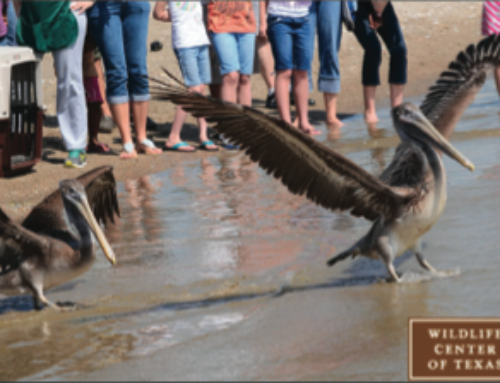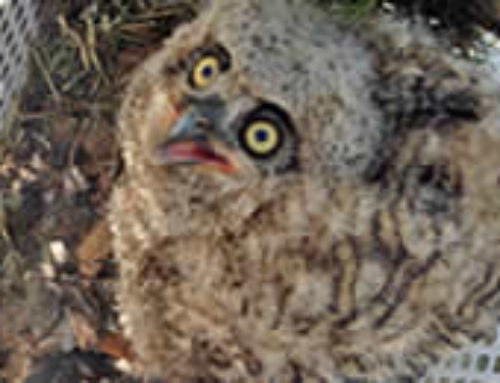If there is a bird that can hold one in thrall, it is the Bald Eagle (Haliaeetus leucocephalus). The raptor simply radiates an aura of power and control. The Bald Eagle is classified as a sea eagle because it prefers to snatch fish from the water as it swoops across the surface of the water. It loves fish so much that it has been known to wade into shallow streams in pursuit of salmon. In regions where fish isn’t as plentiful as Alaska and the coastal northwestern states, the eagle will supplement with waterfowl and small mammals. It is the only eagle unique to North America.
The Bald Eagle that came to the Wildlife Center had lost little of its regal poise even though it was so weak that it could barely fly. Wildlife Center veterinarians arrived within minutes of the bird and began examination and rehydration immediately. The eagle was treated for a parasitic nematode and placed on cage rest. Radiographs revealed an old break of the scapula that had not healed well. Examination with an opthalmascope revealed damage to one eye. Sexing birds that are not dimorphic (male and female do not look alike) is always a tricky business, but veterinarians believe that based on the shape of the pelvic bones that this bird is a male.
 It is believed that the single largest cause of mortality for the Bald Eagle is man and man-made creations. The Bald Eagle population in the lower 48 states began to decline as soon as humans moved in and began changing the habitat and competing for the same game birds and fish as the eagle. Unlike falcons that have adapted to and in some cases exploited human habitation, the Bald Eagle prefers to remain at least a mile from even lightly populated areas.
It is believed that the single largest cause of mortality for the Bald Eagle is man and man-made creations. The Bald Eagle population in the lower 48 states began to decline as soon as humans moved in and began changing the habitat and competing for the same game birds and fish as the eagle. Unlike falcons that have adapted to and in some cases exploited human habitation, the Bald Eagle prefers to remain at least a mile from even lightly populated areas.
By the 1930’s people had noticed the decline of the Bald Eagle and in 1940 the Bald Eagle Act was passed. The act afforded the Bald Eagle protection from harassment. This harassment usually came in lethal forms as farmers, ranchers and fishermen attempted to prevent the eagles from feeding. They were mistaken in their belief that the eagles were having a negative impact on farm animals, cattle and salmon. The Bald Eagle is opportunistic and will readily eat fresh carrion, so when found feeding on a calf, the truth is the calf was already dead when the Bald Eagle showed up. With the exception of the occasional chicken, documented kills of anything over ten pounds is rare. The reason for this is that the comfortable lift weight for a Bald Eagle is four pounds. Yes, they can lift more, but rarely do. They also pick off the less successful salmon therefore improving the overall stock and clean up the environment by eating the fish once they spawn and begin to die.
Despite the Eagle Act, Alaska salmon fishermen systematically hunted and poisoned more than 100,000 Bald Eagles between 1917 and 1953. By the 1950’s and 1960’s individual states began to list the Bald Eagle as endangered and in 1967 in an act that preceded the Endangered Species Act, eagles above the 40th parallel received additional protections. In 1973, President Nixon signed the landmark Endangered Species Act thereby giving the Bald Eagle complete protection as a threatened species.
But what led to the need to list the Bald Eagle as a threatened species? The causes are multitude, but they all distill to man. In a process called biomagnification, the toxins found in the environment are concentrated in each link of the food chain. As an apex predator, the Bald Eagle is exposed to the maximum concentrations of any pollutant or biohazard. Unlike some apex predators, the Bald Eagle does not have robust biochemical processes to protect itself. In this way, raptors, but the Bald Eagle in particular were the “canary in the mine” with respect to the pesticide DDT. DDT interferes with the metabolism of calcium thereby rendering the raptors sterile or producing eggs with shells too thin to withstand brooding. Interruption of calcium metabolism can also affect bones and the entire neurologic system.
The protections afforded the species by the Endangered Species Act has led to a recovery of the Bald Eagle in the lower 48 states. This remarkable turnaround led to the delisting of the Bald Eagle in 2007. While no longer listed as threatened, the Bald Eagle still enjoys protections under state, federal and international law. Intentional and unintentional death of a Bald Eagle is an offense that carries heavy civil and criminal consequences including imprisonment. For example, a farmer put out poisoned bait for the coyotes that are eating his wild turkeys. Yes, he killed eight coyotes, but he also killed many other animals that either fed on the bait or the carcasses of the dead  coyotes including three Bald Eagles, Great Horned Owl and Red-tailed Hawk. For this he was fined $10,000 received a 2 year suspended sentence. As a federal felon he lost the right to vote, hold public office or own firearms. Only a presidential pardon could (and later did) restore those privileges.
coyotes including three Bald Eagles, Great Horned Owl and Red-tailed Hawk. For this he was fined $10,000 received a 2 year suspended sentence. As a federal felon he lost the right to vote, hold public office or own firearms. Only a presidential pardon could (and later did) restore those privileges.
Contrary to the lore surrounding the founding of our country, Benjamin Franklin did not lobby for the turkey as our national symbol. He wasn’t however a fan of the Bald Eagle. In a letter to his daughter, he questioned the propriety of selecting the Bald Eagle to represent the “brave & honest cincinnati of America”. This is based on Franklin’s belief that the eagle is of “bad moral character” since it prefers to steal its dinner from someone else than “get(ting) his Living honestly”. He also believed that the eagle was a “rank coward” for allowing birds smaller than a sparrow to drive it away. He pointed out to his daughter that it didn’t matter anyway since the bird on the national seal looked like a turkey and a turkey “was a more respectable bird, though a little vain and silly it is a bird of courage”. What did Franklin want as our national symbol? The rattlesnake.
Old Ben was right about the Bald Eagle not “get(ting) his Living honestly. When possible, the Bald Eagle has the nasty habit of stealing other animal’s food. Termed kleptoparasitism, the Bald Eagle will steal fish from other sea eagles and hawks and even force bears to relinquish their meal. But the charge of being a “rank coward” doesn’t hold water. Like most raptors, the Bald Eagle can be pestered off of a roost by smaller birds not because it is a coward but because it just isn’t worth the hassle.
The life cycle of the Bald Eagle is quite complex. It takes on average five years for fledgling to become sexually mature. Not all Bald Eagles migrate, in regions where there are large bodies of water that do not freeze (hydroelectric dams and power plant warm water outlets) they will remain year round. Otherwise, as bodies of water freeze, the eagles will slowly make their way to the coast or other large bodies of open water. Populations in regions that don’t experience freezing of the open water often choose to remain in place.
Bald Eagles mate for life. Should one die prematurely, they will quickly select a new mate. Sometimes if a couple hasn’t produced a successful brood after several tries they will separate to find new mates. Both parents share brooding and feeding of the hatchlings. Sometimes more than two offspring are produced, but it is rare that more than two survive to fledging. Life in the nest is all about survival of the fittest and the biggest and strongest will only become more so.
Fledglings leave to migrate prior to the parents and frequently do not migrate to their parent’s wintering grounds. Instead they chart their own path. Birds banded in Florida have been sighted in the far northeast and on rare occasions found in the UK. After five years, many will return to the general region of their birth with their mate to start the next generation. Unlike the leasurely flight south when the birds will often linger for a week or more at different sites, the trip to the nesting ground happens without delay. It is estimated that the lifespan in the wild is about thirty years, but in captivity fifty years has been documented.
The progression of change necessary to produce the magnificent white head and tail is not a straight line. Born in shades of brown, the eagle spends its first year uniformly brown with a dark beak and dark brown eyes. The second year the eyes turn gray or whitish and the body is sprinkled with whitish ticking. By year three, the white seems to be migrating to the head and tail. The beak and eyes become yellow. Year four brings a body and wings that are mostly brown and the head and tail are mostly white. The tail will retain a dark terminal band. Year five finds the raptor in full sexual maturity and the bothersome white mottling is gone from the body and wings and the head and tail are a full and glorious white. During the first two years, an immature Bald Eagle can be mistaken for a Golden Eagle.
The Bald Eagle that found his way to the Wildlife Center was probably almost five years old since his body is solid brown, but he still retains shadowing of brown around the neck. He is eating well and it is expected he will make a full recovery. It is believed that the old scapula break hindered his ability to hunt. Since it is harder to find prey in cold weather, a minor problem in the summer could have proven to be fatal now. The Bald Eagle will be moved to a large flight cage once he is healthy again to determine how strong he can fly. If he can hunt for himself, he will be released. If not, he will be placed in an accredited education program. Either way, he will be ensured a good life.







There were a pair of bald eagles that nested off Highway 90 near the San Jacinto River Bridge right down the road from Crosby. I wonder if this is one of that pair? I hope he gets well soon and is strong enough to be released back near where he was found.
This Bald Eagle is young enough that it might not be mated yet. It will take a week or more to bring his weight back up to normal, make sure his eye heals properly and evaluate how the old break affects his ability to fly. Should it be learned that he is mated and he proves to be releasable, all efforts will be made to reunite them.
Thank you for this account. I enjoyed reading about this eagle in our midst, getting help from us. This city has some wonderful birds, and my favorites are the raptors. Hawks, owls, and osprey (on the bayfront) are inspiring to see and hear. Owls and hawks abound in the Heights, and their calls and silent flight is inspiring.
Just tonight, my wife and I marvelled at great numbers of blackbirds/grackels flying manuvers, and enlivening the city street with chatter, at dusk!
Keep up the good work!
Thanks-
Paul
Can you give an update on this bald eagle?
He’s been transferred to someone that has the permits and the huge flight necessary for him to exercise his wings.